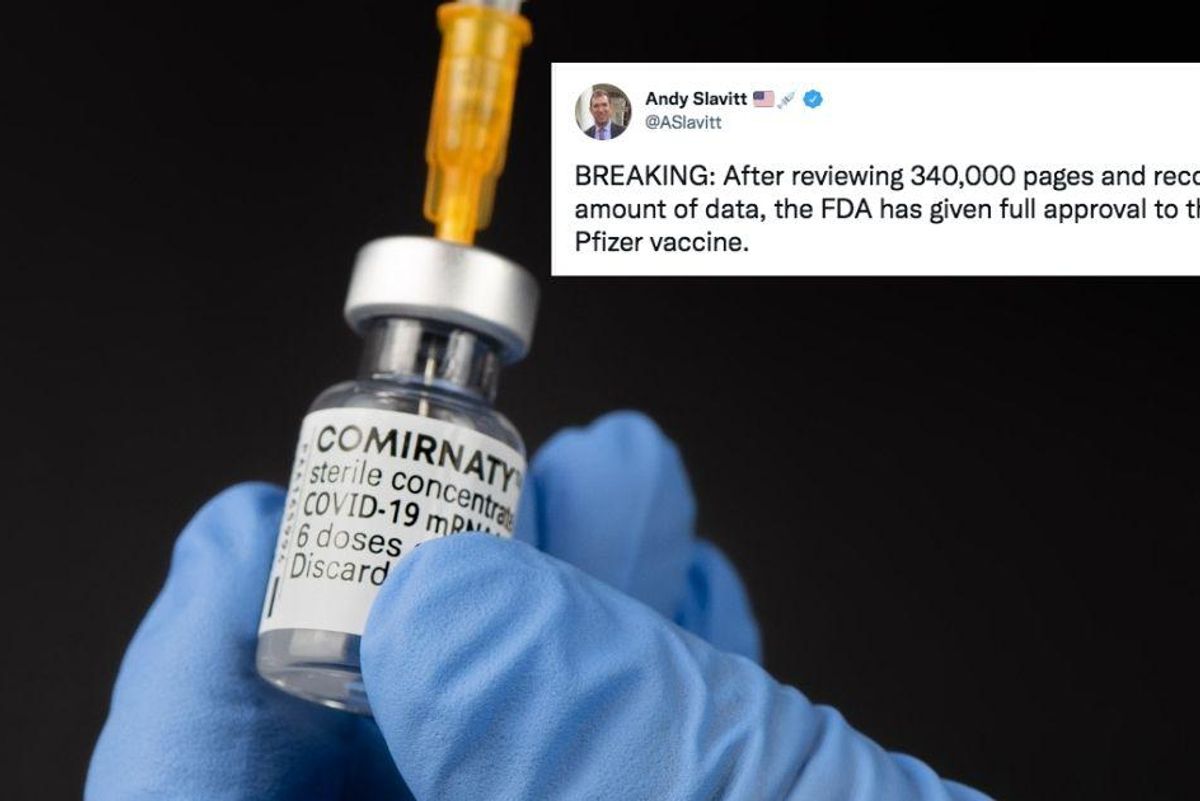The Pfizer vaccine gets full FDA approval, eliminating a primary argument for not getting it

The FDA has given full approval for the Pfizer COVID-19 vaccine, marking a major milestone in the fight against the global coronavirus pandemic.
Since FDA Emergency Use Authorization was issued for the Pfizer, Moderna, and Johnson & Johnson vaccines earlier this year, some hesitant people have refused to get the vaccine, citing the fact that it wasn't fully approved by the FDA. Now that full FDA approval has been granted for the Pfizer vaccine (which is actually officially named Comirnaty—who knew?), that argument is moot. And with Moderna's approval submission clocking about a month after Pfizer, it's entirely likely we'll have two fully approved vaccines for COVID-19 in the coming weeks.
The big question now is—will it actually make that much difference?
On the hopeful side, the Kaiser Family Foundation found that 31% of unvaccinated Americans they surveyed last month indicated that they would be more likely to get vaccinated if the vaccine received full FDA approval. If all of those people changed their minds due to this approval, we'd have millions more Americans receiving the vaccine. With hospitals filling up with unvaccinated people across the country, putting a heavy strain on already burnt-out healthcare workers, getting more people vaccinated is imperative.
But even full approval doesn't seem to be budging the die-hard never-vaxxers.
A small-but-loud minority of Americans simply have a blanket distrust of the FDA (or any government regulatory agency), and this full approval is just seen as another untrustworthy move by an untrusted source. Social media today is filled with people asking how much the FDA was paid to give this full approval. Figuring out how to reach these people is an ongoing mystery.
Another minority of Americans are immersed in media that pushes misinformation about the vaccines and the pandemic in general, leading people to the erroneous belief that they're better off risking a COVID infection than getting the vaccine. Though COVID misinformation can be outright lies, more often it's studies or statistics or stories that are cherry-picked and used in misleading ways. (Watch the comments on this article if you read it on Facebook. There will be no shortage of such misinformation being shared. Happens every time.)
One example of such misleading information is reports of the number of vaccine reactions in VAERS, the U.S. government's Vaccine Adverse Events Reporting System. If a person were to just look at the numbers in that database (which is available for anyone to see) without proper analysis, they could easily believe that the vaccines were dangerous, leading to thousands of people's deaths and sickening thousands more.
However VAERS numbers have to be taken for what they are—self-reported, unverified reactions that 1) may not be real or accurate since anyone can submit to it, and 2) have not been demonstrated to actually be caused by the vaccine.
Here's one example of why raw VAERS numbers are essentially meaningless: When we're vaccinating more than 100 million people in a handful of months, basic statistics would tell us that a certain number of those people will die of out-of-the-blue heart attacks, strokes, aneurysms, or other sudden death events within a close window of receiving the vaccine, even though such events actually have nothing to do with the vaccine.
Here's how that math works: According to the American Public Health Association, around 2,200 Americans die each day of heart attack, stroke and other cardiovascular diseases every day. That's about one person every 40 seconds, and that's in years when there's not a mass vaccination effort happening. At the peak of vaccinations in April, the U.S. was administering over 1,300 vaccine doses every 40 seconds. Statistically, it's completely expected that some sudden deaths would coincide closely with a vaccine dose—but that doesn't mean that the vaccine caused them. Doctors investigate all reported deaths following vaccines, and there is simply no indication that vaccines are causing people to die or be severely impacted in any statistically significant way.
One might assume that the FDA's pause of the Johnson & Johnson vaccine for safety review when a correlation between the vaccine and a higher than normal incidence of rare, severe (but treatable) blood clots was discovered would have given people some faith that the safety monitoring systems work as they should. But memories are short and paranoia is high. Add in the fact that we're watching science happen in real-time, and that accurate information and guidance have changed many times as we've learned more, and it's not surprising that a lot of people simply don't know what to think anymore.
While this full FDA approval won't convince everyone who is hesitant to get the vaccine, hopefully it will convince some. (For those still on the fence, you can read the FDA insert that will now accompany the Pfizer vaccine here and an FAQ about the vaccine and the approval of it here.)
As always, look to the majority of experts in the epidemiology/virology/immunology fields for accurate information and ignore the handful of skeptics-with-credentials who thrive on social media attention and feed on people's distrust of institutions and authority. And for the love, run from anyone who says, "Do your own research," unless you actually have the expertise and ability to conduct clinical research. (For real, watching YouTube videos and searching hashtags on Twitter does not count.)
Let's celebrate the incredible medical feat of the world's top medical scientists during the pandemic, do our part to mitigate the spread of COVID-19, and get the free, widely available, and now fully FDA-approved vaccine as soon as possible.
- The science deniers are losing: Support for immunization jumps in ... ›
- COVID vaccine misinformation is out of hand. Let's examine some of ... ›
- Montana's Blackfeet Tribe has gifted hundreds of COVID vaccines to ... ›

